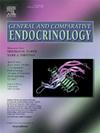黄热病蚊子埃及伊蚊体内 CCHamides 的功能特征及其受体的非形态化。
IF 1.7
3区 医学
Q3 ENDOCRINOLOGY & METABOLISM
引用次数: 0
摘要
埃及伊蚊是一种广泛分布的嗜人蚊种,也是各种虫媒病毒的传播媒介,在全球范围内对人类健康构成重大威胁。通过研究蚊子的神经肽,我们可以更好地了解它们的生理机能。最近发现了神经肽 CCHamide1(CCHa1)和 CCHamide-2(CCHa2)及其相关的 G 蛋白偶联受体(CCHa1R 和 CCHa2R),并对其进行了跨昆虫研究。然而,CCH酰胺及其受体在包括埃及蚁在内的许多其他昆虫中的表达谱和生理作用仍不清楚。本研究旨在量化和定位 CCHamides 及其受体的表达,并深入了解它们在黄热病蚊子中的生理功能。RT-qPCR 分析显示,CCHamides 及其受体的转录本丰度随发育过程而变化。在成蚊的组织/器官中也观察到了差异表达,表明 CCHa1 和 CCHa2 转录本富集在中肠,而受体则在不同组织中表达。在大脑和腹侧神经索的神经元中观察到了 CCHamide 免疫反应,在后中肠邻近中肠-后肠交界处的肠内分泌细胞中也观察到了 CCHamide 免疫反应,这证实了它们的转录本表达谱。利用不同的质谱方法,证实了 CCHamides 存在于雌雄蚊子的大脑(包括雌蚊的间脑旁)和成蚊的肠道中。为了对预测的CCHamides进行化学鉴定,我们用ESI-Q Exactive Orbitrap MS分析了大脑和肠道提取物,结果碎片证实了雌雄蚊子大脑和中肠样本中的CCHa1和CCHa2。通过评估两种 CCHamide 受体对多种蚊虫肽的激活反应,使用异源功能测试确认了这两种受体的特异性和灵敏度,从而证实 CCHa1 和 CCHa2 是天然配体。最后,利用毛细管喂食器(CAFE)生物测定,我们的结果表明 CCHa2 能够调节雌蚊的摄食行为。本文章由计算机程序翻译,如有差异,请以英文原文为准。
Functional characterization of CCHamides and deorphanization of their receptors in the yellow fever mosquito, Aedes aegypti
As a widely distributed anthropophilic mosquito species and vector of various arboviruses, Aedes aegypti poses a significant threat to human health on a global scale. Investigating mosquito neuropeptides allows us to better understand their physiology. The neuropeptides CCHamide1 (CCHa1) and CCHamide2 (CCHa2) along with their associated G protein-coupled receptors (CCHa1R and CCHa2R) were recently identified and studied across insects. However, expression profiles and physiological roles of CCHamides and their receptors in many other insects, including A. aegypti, remain unclear. This research aimed to quantify and localize the expression of CCHamides along with their receptors and gain insight on their physiological function in the yellow fever mosquito. RT-qPCR analysis revealed transcript abundance of CCHamides and receptors changes over development. Differential expression was also observed in tissues/organs of adult mosquitoes indicating CCHa1 and CCHa2 transcripts are enriched in the midgut, while receptors are expressed across various tissues. CCHamide immunoreactivity was observed in neurons in the brain and ventral nerve cord along with enteroendocrine cells in the posterior midgut adjacent to the midgut-hindgut junction, corroborating their transcript expression profiles. Using different mass spectrometrical approaches, presence of CCHamides were confirmed in the brain of both sexes, including the pars intercerebralis of female mosquitoes, as well as in the gut of adult mosquitoes. For chemical identification of predicted CCHamides, we analyzed brain and gut extracts by ESI-Q Exactive Orbitrap MS and resulting fragmentations confirmed CCHa1 and CCHa2 in brain and midgut samples of both male and female mosquitoes. A heterologous functional assay was used to confirm the specificity and sensitivity of the two CCHamide receptors by assessing their activation in response to diverse mosquito peptides, which confirmed CCHa1 and CCHa2 as natural ligands. Finally, using a capillary feeder (CAFE) bioassay, our results suggest that CCHa2 modulates feeding behaviour in female mosquitoes.
求助全文
通过发布文献求助,成功后即可免费获取论文全文。
去求助
来源期刊

General and comparative endocrinology
医学-内分泌学与代谢
CiteScore
5.60
自引率
7.40%
发文量
120
审稿时长
2 months
期刊介绍:
General and Comparative Endocrinology publishes articles concerned with the many complexities of vertebrate and invertebrate endocrine systems at the sub-molecular, molecular, cellular and organismal levels of analysis.
 求助内容:
求助内容: 应助结果提醒方式:
应助结果提醒方式:


